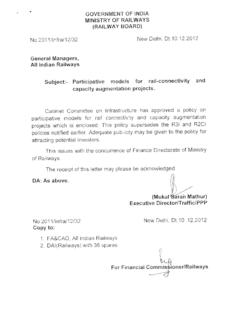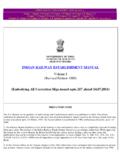Transcription of CASE STUDY ON PERFORMANCE MANAGEMENT …
1 127 CASE STUDY ON PERFORMANCE MANAGEMENT SYSTEM IN INDIAN RAILWAY Dr. A. Nilasco Arputharaj, Southern railways , mail: Every good PERFORMANCE deserves an equivalent reward after a proper assessment. The Public Sector Undertakings in India including indian railways are following the traditional Confidential Report Writing system. Seldom is the potential of the individual reflected in his PERFORMANCE . What he is? is different from how he performs ? To make his potential capabilities into the actual, motivation is basically needed. Motivation is generated by training, promotion and incentives. To identify the same, PERFORMANCE Appraisal is necessary. Different PERFORMANCE MANAGEMENT systems in Private Companies Many Private Companies are following latest techniques of PERFORMANCE Appraisal systems like 360 degree system.
2 Since big companies and Multi-national Corporations have well structured PERFORMANCE MANAGEMENT system and PERFORMANCE Linked Reward system, the high performing human capital started moving slowly toward those sectors. If such a scenario continues, Indian public sector will be left out with the only low performers. Hence, a serious thinking on attracting and retaining the high performers becomes mandatory. Hence this paper attempts to STUDY the existing system in indian railways and its credibility. There are different types of employee appraisal systems such as rating by superiors, feedback on appraisal information, field review technique, rating by self and peer group, 360 degree PERFORMANCE Appraisal System and so on. Among the various systems, the 360 degree PERFORMANCE Appraisal System is the modern and widely accepted system.
3 This system collects feedbacks from all around. Traditional methods include Field review technique, Ranking Method, Checklist method, Graphic Rating Method, Paired Comparison Methods, Forced Choice List Method, Critical Incidence Method, Forced Distribution Method, Confidence Report writing method etc. The Modern methods include Behaviorally Anchored Rating Scales (BARS) method, MANAGEMENT By Objective (MBO) method, Group or team appraisal method, Human resource accounting method, 360 degree appraisal method, Potential appraisal method, Self appraisal method etc. The area of STUDY The area of STUDY is indian railways . The Ministry of railways in India is in charge of the indian railways , the state-owned company that enjoys a monopoly in Rail transport in Case STUDY On PERFORMANCE MANAGEMENT System In Indian Railway 128 India.
4 The Railway Board which is the apex body of the indian railways reports to this ministry. Every day nearly crores people are travelling by indian railways . As per the 6th Pay Commission Report, the indian railways is the largest civilian employer in the country. Now, the indian railways comprises sixteen zones, a Metro Railway, Calcutta, six production units, construction organization, and other railway establishments. A vast rail system as India's, the 3rd largest in the world, has been managed at a regional level. indian railways has divided itself into 16 zonal railways . There are currently 67 divisions on the system nationwide. Total number of employees as on 31-3-2005 was 14, 10, 646 (14 lakhs). The distribution of staff strength is: Group A- 8285, Group B- 7247, Group C- 873536 and Group D - 521578.
5 The annual Budget presented by the Ministry of railways reveal that it is generating surplus (net revenue receipts) to the tune of more than Rs. 5,000 crores annually. Thus indian railways has proved itself as a economically and socially viable organization. This structure is considered for the STUDY . There are 16 Railway zones in the Indian Railway. Each zone is has at least 6 divisions. Of these Southern Railway is the zone with the head quarters at Chennai. Southern Railway, which is chosen for the STUDY consists of six divisions viz. Chennai (MAS), Tiruchirappalli (TPJ), Madurai (MDU), Palghat (PGT), Trivandrum (TVC) and the newly formed Salem (SA). The existing PERFORMANCE Appraisal system in the railways The existing system adopted in indian railways is called as Confidential Report Writing System.
6 This is adopted for non-gazetted railway servants. The Confidential Report is an important document, providing for the basic and vital inputs necessary for assessing the PERFORMANCE of a Railway servant for his/her advancement in official career. The report is written annually on every Railway servant, except those mentioned below, in the form prescribed for the purpose, generally for the period ending with the financial year, appraising the PERFORMANCE , character, conduct and qualities of the concerned Railway servant1. The Confidential Report Writing is not used for the following groups of staff: Group D Railway Servants: [Ref: Board s letter No. E55/CR/3 dated 9-11-1956] 1 Confidential Reports on Non-gazetted Railway servants Master Circular, No.
7 E (NG)I/90/CR/4, dated Prestige International Journal of MANAGEMENT & IT- Sanchayan, Vol. 2(1), 2013, ISSN: 2277-1689 (Print), 2278 8441 (Online) 129 Group C Railway servants in the initial recruitment grade of Rs/950-1500 (RPS), except those working in the Ministry of railways ; [Ref: Board s letter No. E[NG] 57/CR3/1 dated ] Group C Railway servants whose initial grade is higher than the grade of (RPS) provided the next higher grade for them is a non-selection grade, except in the case of Skilled & II. Artisans staff for whom Confidential Report shall be written for those in two grades below the selection grade. In respect of Railway servants working in grade (RPS) and in grades above , likely to be considered for promotion to Group B Gazetted service, an additional section called Section-II is required to be written in the prescribed form.
8 Different Forms of CR Writing Systems for Group C Employees There are six different forms used in writing the Confidential Report for Group C staff (PB 1/1619). The first part of each of the forms is designed to get the personal information such, name, date of birth, designation, station employed, pay (both substantive and officiating), date of appointment, date of entry in the present grade, permanent/temporary status, qualification (educational, professional and technical), particulars of examinations passed (including departmental) and whether belonging to SC/ST community. The second part deals with the self-appraisal in which the employee himself has to declare his prescribed duties and brief resume of work done during the assessment year.
9 The third part is the part that gives the data regarding the assessment by the reporting officer usually the supervisor under whom the employee is working. The fourth part has the remarks by the reviewing officer. The six different forms of Group C staff are as follows: 1. The form (PB1/1619-R) Annexure I A is used in writing the Confidential Report for the Station masters and Station Superintendents. 2. The form (PB1/1619-R/Rev. 04) Annexure I is used in the Confidential Report writing for the Group C staff including workshop staff except PWI s, APWIs, Signal Inspectors, Assistant Signal Inspectors and teachers / instructors. 3. The form (PB1/1619-R) Annexure II is used in writing the Confidential Report for the , 4. The form (PB1/1619-R) Annexure III is the form used in writing the Confidential Report for the Group C staff ( , ): 5.
10 The form (PB1/1619-R) Annexure IV is the form used in the writing of Confidential Report for Teachers/Instructors in Teaching and Training Schools. Case STUDY On PERFORMANCE MANAGEMENT System In Indian Railway 130 6. The form (PB1/1619-R/REV 2K) Annexure V: Confidential Report for the staff in scale Rs. 4500-7000 grades of 5th pay commission. Confidential Report for the Group C staff (PB-1/1619-R / ANNEXURE I-A) For a sample, this form of Station Masters and Station Superintends is studied. Part I, consists of the personal information of the staff and the part II consists of self- appraisal. Personal Data: The part I consists of personal information such as name, date of birth, designation (IF Army personnel, their Territorial Army rank also should be given), station employed, pay (both substantive and officiating), date of appointment, date of entry in the present grade, permanent/temporary status, qualification (educational, professional and technical), particulars of examinations passed (including departmental) and whether belonging to SC/ST community.


